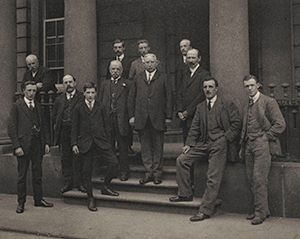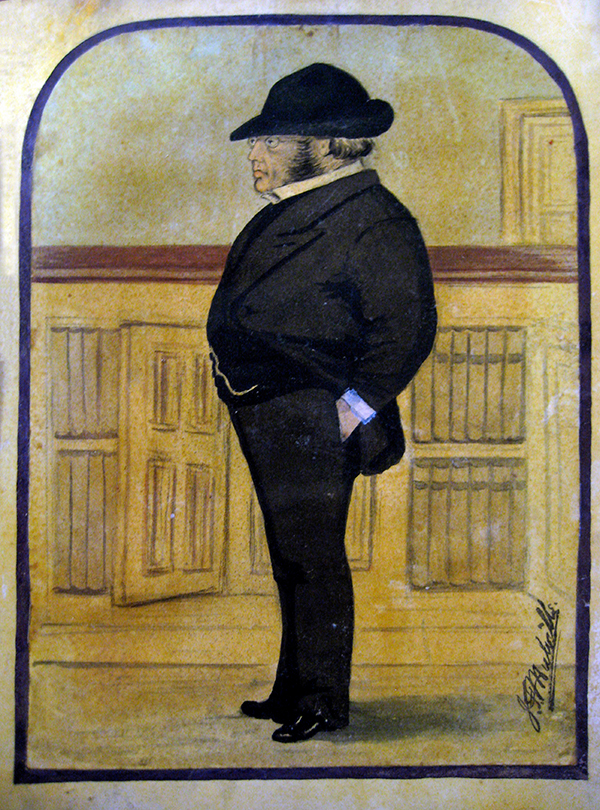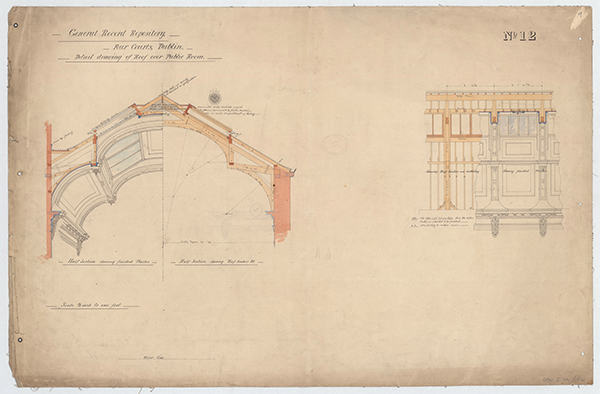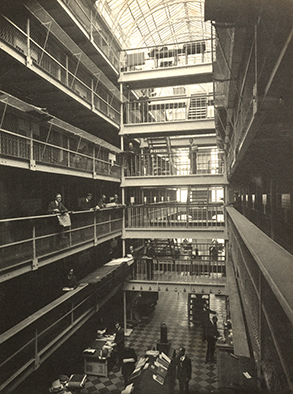‘The great untilled field’—the Public Record Office of Ireland, 1867–1922
Published in Features, Issue 3 (May/June 2021), Volume 29In this, the second of three articles counting down to the centenary of the Four Courts fire in June 2022, the directors of Beyond 2022 examine the Public Record Office of Ireland and its 55-year history as a living institution.
By Peter Crooks and Ciarán Wallace
The destruction of the Public Record Office of Ireland (PROI) on 30 June 1922, amid flame and smoke and civil war, has obscured our view of its remarkable 55-year history as a living institution. Between its foundation in 1867 and 1922 the PROI accomplished an amazing feat. Its personnel gathered dispersed collections of public records from across Ireland and deposited them in a modern, purpose-built repository. Ancient documents numbering in the tens of thousands were sorted, flattened, cleaned and stored. A dedicated professional staff produced finding aids, catalogues and calendars.
Perhaps most inspiring today was the ethos of the office. The PROI held great reverence for ‘original sources of history’ but it was strikingly modern in its commitment to widening access. These records were the public’s records. As Herbert Wood, Deputy Keeper of the PROI, wrote in 1912, ten years before the blaze that consumed his life’s work, ‘There is a great untilled field awaiting the historical student, and to such we of the Records Office offer a cordial welcome’.
Keepers and searchers

Above: PROI ‘searchers’ in 1914 – among them J.J. Tucker Jr (back row, second from the right), the third generation of his family to hold that position. (NAI)
The PROI was particularly fortunate in its first chief, Samuel Ferguson (1810–86), who bore the title of Deputy Keeper from 1867 until his death. Ferguson was a polymath: barrister, poet, historian, antiquarian, folklorist and unionist-turned-Repealer with a gift for Irish translation. The PROI’s early administrative files show his flair for organisation—and even for engineering. His detailed instructions to manufacturers contain precise diagrams of bespoke shelving brackets and other fittings needed to store particular collections.
Ferguson’s courtesy and diplomatic nature made him an ideal senior officer, but the talent among the ranks of the early officers of the PROI is extraordinary. A passionate and self-proclaimed ‘Irish archivist’, John T. Gilbert (1829–98) had coveted the top job in the new archive but was passed over as Deputy Keeper and appointed instead as ‘Secretary’, a specially created consolation prize to ensure that his expertise and energies were used for the good of Irish records.
The senior team at the PROI included men with special knowledge of particular collections. Deputy Keeper John J. La Touche and First Class Clerk William H. Hennessy also had a good command of the Irish language, particularly valuable for deciphering place-names on old documents. Ferguson kept up a long correspondence with the Civil Service Commission in London, insisting that proficiency in Irish was essential for recruits to the PROI.

SIR SAMUEL FERGUSON
The PROI was particularly fortunate in its first chief, Sir Samuel Ferguson, who bore the title of Deputy Keeper from 1867 until his death in 1886. (NAI)
In addition to the pen-pushers, there were seven permanent and eleven temporary ‘searchers’ who fetched documents from the Record Treasury, three bookbinders, a messenger, a ‘boy learner’ and a housekeeper on the staff. Richard Tucker, foreman searcher when the archive opened, secured apartments for his family on the top floor of the PROI administration block. He was succeeded by his son, J.J. Tucker. By 1912 his grandson J.J. (junior) was on the permanent staff. Following the destruction of the Four Courts complex in June 1922, Mrs M.J. Tucker, ‘late housemaid at the PROI’, claimed compensation for loss of earnings.
Many of the archival staff were active members of Dublin’s busy scholarly networks in the late nineteenth and early twentieth centuries. The Royal Irish Academy, the Royal Society of Antiquaries and the Social and Statistical Inquiry Society of Ireland published papers delivered by officers of the PROI, on topics from the Templars in Ireland and early references to tobacco in the records to social conditions in Dublin’s tenements.
Opening access
In the early years the Deputy Keeper’s annual reports set out detailed descriptions of the collections being brought into the Record Treasury. The archivist responsible for the transfer and removal of the records in the Affidavit Office in the Court of Chancery or the State Papers in the Record Tower reported on their contents and condition. As the older repositories were emptied and the Record Treasury filled up, the archivists turned their attention to making these records more accessible.
Starting in 1874 with a brief two-page transcript from the Minutes of Trustees for the Encouragement of the Linen Manufacturers in Ireland (1711), this work quickly grew. The first 60-page instalment of the Calendar of the fiants of Henry VIII appeared in 1874. The mammoth task of arranging, repairing and publishing calendar entries for almost 9,000 fiants, up to the reign of Charles I, kept the staff busy for 21 years and ran to over 2,300 pages. PROI staff created indexes for important but fragile volumes, allowing researchers to locate specific people or places while reducing wear and tear on the ancient records.
Expertise in history, palaeography and translation were all deployed to protect and uncover the contents of some of Ireland’s oldest records. Indeed, so successful was the PROI that non-State organisations sought permission to deposit their records in the safety of the Record Treasury. The Christ Church Deeds, dating back to the 1170s, were welcomed onto the shelves, and a calendar and index were duly prepared and printed. Among them was a chance find—the earliest known morality play in the English language, perhaps performed in a pageant on Dublin’s streets in the 1340s.
New government policy could increase the work in unexpected ways. Disestablishment of the Church of Ireland in 1869 meant that all birth, marriage and burial records, plus other official church papers, over twenty years old were transferred from hundreds of parishes to the PROI. When this proved a major inconvenience for many local clergy the rules were amended and the records returned, but only after a survey had confirmed that each parish had a fire-proof safe in which to store them. The introduction of the Old Age Pension in 1909 created an avalanche of public enquiries. Those entitled to claim a pension in its early years would have been born prior to the Registration of Births and Deaths Act in 1874. To prove their age and entitlement to a pension, claimants had to request confirmation that they appeared on the 1841 census. From all over Ireland claimants sent in vague and inaccurate details seeking confirmation that they were indeed recorded as having been born before 1841. The extra costs in temporary staff, stationery and postage were a headache for both the PROI and the Treasury, but thanks to this new social reform the archive was suddenly the most popular State agency in the country.
Located beside a match factory
Productive and popular as the PROI may have been, life for the institution was not without its challenges. To begin with, the building was not well finished. An engineer’s report expressed shock at the poor quality of the workmanship on the iron beams and fittings. As the upper floors were loaded with tons of records, the girders below began to buckle and reinforcing works were needed. Alarmingly, the huge glass roof running the length of the building was found to be insecurely fixed to its supports. It was held in place only by its own weight, so that wind getting under it during a severe gale could have lifted the entire structure off.
The surrounding area of Church Street and Hammond Lane boasted two foundries, a metalworks, glassworks and a match factory. With so many furnaces in the immediate neighbourhood the PROI was lucky to escape serious harm in April 1878, when an explosion at Strong’s Foundry, Hammond Lane, killed over a dozen people and flung bricks and debris across the roofs of the Four Courts.

Above: Architectural drawing of the roof of the ‘Public Room’, later known as the ‘Search Room’ (i.e. reading room). (NAI/OPW)
The risk from political disturbance was unforeseeable back in 1867, but in 1916 the Volunteers identified the Four Courts complex as a strategic point during the Rising. Occupying the PROI for Easter Week, they used large volumes in place of sandbags to block up the windows in the archive’s administration block. Following the surrender, the staff of the PROI were able to identify which records had been moved or damaged. In the following year’s annual report, the Deputy Keeper could confirm that all records had been located and any damage repaired, with the single exception of a soldier’s will from 1858. If nothing else, this work of restoration was a tribute to the meticulous cataloguing of the collections in their care.
‘A malignant destiny’

Above: Interior of the Record Treasury. Alarmingly, the huge glass roof running the length of the building was found to be insecurely fixed to its supports. It was held in place only by its own weight, so that wind getting under it during a severe gale could have lifted the entire structure off. (NAI)
The next military occupation did not end so well. When the anti-Treaty forces seized the Four Courts on Good Friday 1922, they were consciously emulating the events of the 1916 Rising. For eight weeks life at the Four Courts continued, but it was not business as usual for the Record Office staff, who took up offices in Dublin Castle. The new occupants of the Four Courts enjoyed a relaxed existence, preparing defensive positions by day and occasionally heading out for a drink or to a dance by night. As the debate over the Treaty slipped from the political to the military arena, however, anxiety for Ireland’s ancient records grew in the scholarly community.
Michael J. McEnery, former Deputy Keeper of the Records and in 1922 president of the Royal Society of Antiquaries of Ireland, wrote to the Provisional Government and to Eamon de Valera, naming some carefully selected records such as ‘documents concerned with the dissolution of the monasteries, wills … and census returns’. ‘The loss of all or any of these documents’, he emphasised, ‘would be irreparable’ (NLI MS 22,433: McEnery Papers). Both sides assured McEnery that they understood the importance of the PROI and that all necessary steps were being taken to protect the records.
In the event, of course, promises made before the heat of battle proved impossible to keep, and the Record Treasury, with seven centuries of Irish historical records, was entirely destroyed (see ‘The Battle of the Four Courts, 28–30 June 1922’, HI 27.4, July/August 2019). ‘A malignant destiny seems to have followed the preservation of the Irish Public Records for centuries’, wrote Herbert Wood in the months after the fire, following his inspection of the ruins at the Four Courts. The loss of the PROI had created a chasm in Irish historical research. ‘An odd Plea Roll or Parish Register may have survived, but I am confident that the great bulk of the Irish Public Records has gone for ever.’ It was a remarkably measured comment on the archival tragedy of 1922. Even as Wood noted that the ‘loss of the originals will ever be a source of sorrow to the Irish historian’, he also recorded his satisfaction that the ‘research work which has been going on … for the last fifty years’ had made its way into learned publications for posterity.
Wood was prescient about the lasting value of professional archival work. As tragic as the explosion and fire were, the death of the PROI should not obscure its success in its short lifetime. Beyond 2022’s virtual recreation of the lost Record Treasury and—as far as is possible—its destroyed collections rests on the achievement of the PROI during its 55 years of protecting Ireland’s archival heritage.
Peter Crooks is Senior Lecturer in the Department of History, Trinity College Dublin, and Director of the Beyond 2022 Project; Ciarán Wallace is Deputy Director.
Further reading
P. Connnolly, ‘The destruction of the Public Record Office of Ireland in 1922: disaster and recovery’, Archivum 42 (1996).
M. Fewer, Battle of the Four Courts (London, 2019).
G. Ó Dúill, ‘Sir Samuel Ferguson, administrator and archivist’, Irish University Review 16 (2) (1986), 117–40.
To find out more about the work of Beyond 2022, including a selection of digital resources and the complete reports of the Deputy Keeper of the Public Record Office of Ireland, visit www.beyond2022.ie. The third article in this series (May/June 2022) will explore how the Record Treasury is being reconstructed virtually to mark the centenary of the Four Courts blaze.
















